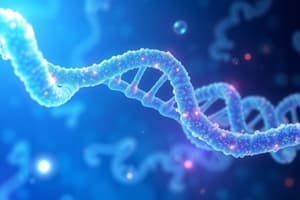Podcast
Questions and Answers
Explain the process of homologous recombination during Meiosis I.
Explain the process of homologous recombination during Meiosis I.
Homologous recombination occurs during Meiosis I when homologous chromosomes align and exchange genetic material. This exchange, known as crossing over, occurs between the inner chromatids of the homologous chromosomes, resulting in genetic diversity.
Do sex chromosomes undergo crossing over during Meiosis?
Do sex chromosomes undergo crossing over during Meiosis?
Yes, sex chromosomes do undergo crossing over during Meiosis. However, crossing over occurs at a small section at the tip of the short arm of the sex chromosomes, known as the pseudo-autosomal region.
What is the purpose of sex in biology?
What is the purpose of sex in biology?
The purpose of sex in biology is to generate genetic diversity. This is achieved through the process of gametogenesis, which creates multiple possible chromosome combinations through homologous recombination.
What are the different types of numerical chromosome abnormalities?
What are the different types of numerical chromosome abnormalities?
Define ploidy and explain how it relates to the number of chromosomes in a cell.
Define ploidy and explain how it relates to the number of chromosomes in a cell.
What is the process of fertilization and how does it contribute to the formation of a normal baby?
What is the process of fertilization and how does it contribute to the formation of a normal baby?
Describe the steps of meiosis in the context of the Baby Hofstadter's development.
Describe the steps of meiosis in the context of the Baby Hofstadter's development.
What is the purpose of Molecular Cytogenetics Probe Hybridisation?
What is the purpose of Molecular Cytogenetics Probe Hybridisation?
What is the main use of Fluorescent In Situ Hybridisation (FISH)?
What is the main use of Fluorescent In Situ Hybridisation (FISH)?
What is the purpose of Multiplex FISH (M-FISH)?
What is the purpose of Multiplex FISH (M-FISH)?
What are the two categories of structural chromosome abnormalities?
What are the two categories of structural chromosome abnormalities?
What is the difference between balanced and unbalanced structural chromosome abnormalities?
What is the difference between balanced and unbalanced structural chromosome abnormalities?
What is an example of a balanced structural chromosome abnormality?
What is an example of a balanced structural chromosome abnormality?
Under what circumstances are structural chromosome abnormalities heritable?
Under what circumstances are structural chromosome abnormalities heritable?
What is a deletion in the context of structural chromosome abnormalities?
What is a deletion in the context of structural chromosome abnormalities?
What are the effects of large deletions in chromosomes?
What are the effects of large deletions in chromosomes?
What is an example of a specific deletion syndrome?
What is an example of a specific deletion syndrome?
What are the two states of chromatin condensation in chromosomes?
What are the two states of chromatin condensation in chromosomes?
What are the different types of structural chromosome abnormalities?
What are the different types of structural chromosome abnormalities?
How are gross chromosomal abnormalities named and identified?
How are gross chromosomal abnormalities named and identified?
What are the limitations of conventional cytogenetics in detecting chromosomal changes?
What are the limitations of conventional cytogenetics in detecting chromosomal changes?
What is the International System for Human Cytogenetic Nomenclature (ISCN)?
What is the International System for Human Cytogenetic Nomenclature (ISCN)?
How are chromosome regions counted and subdivided?
How are chromosome regions counted and subdivided?
What is a karyotype and how is it described?
What is a karyotype and how is it described?
What are the different types of sample nucleated cells that can be used for studying chromosomes?
What are the different types of sample nucleated cells that can be used for studying chromosomes?
What is the chemical preparation used to arrest cells and lyse nuclei during chromosome analysis?
What is the chemical preparation used to arrest cells and lyse nuclei during chromosome analysis?
What is the staining method commonly used to visualize chromosomes?
What is the staining method commonly used to visualize chromosomes?
Flashcards are hidden until you start studying




